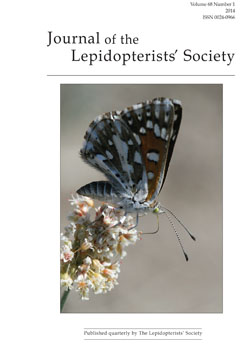Aricoris cinericia (Stichel, 1910) (Figs. 1–5) belongs to “chilensis” species group (sensu Hall & Harvey 2002) and all these species has its distribution restricted to austral South America, especially in open areas from Bolivia, Paraguay, Argentina and Uruguay (Hayward 1951, Hall & Harvey 2002, Callaghan & Soares 2001, Callaghan & Lamas 2004, Bentancur-Viglione 2009, Núñez-Bustos 2010, Núñez-Bustos & Volkmann 2011, Schweizer & Kay 1941, Siewert et al. in press.).
In the early 1970s, a species similar to A. cinericia was collected in Guarapuava municipality (51°27′29″W, 25°23′44″S), Paraná State, Brazil, by Hipólito Schneider and published by Dolibaina et al. (2011). However, a more detailed analysis revealed that the above species was not in fact A. cinericia (Siewert et al. in press), which continues then unrecorded in Brazil.
On 27 November 2012, three male and two female specimens of A. cinericia were recorded for the first time in Brazil, at Fundação Maronna, Alegrete municipality (55°42′58″W, 30°07′12″S), Rio Grande do Sul State, South Brazil. The area is located at the Pampa biome and is a transitional zone between forest and grasslands, a mixture of grassland with scattered shrubs. The individuals were collected on the bottom of a forested valley, at a forest edge, between 9 and 10 h and 18 h. The specimens are deposited at “Coleção de Lepidoptera do Departamento de Zoologia” (CLDZ), Universidade Federal do Rio Grande do Sul, Porto Alegre, Rio Grande do Sul, Brazil, under the codes CLDZ 8227, CLDZ 8228, CLDZ 8229, CLDZ 8230 and CLDZ 8231.
Other records in South America were found in Buenos Aires (a single specimen in Museo Argentino Ciencias Naturales “Bernardino Rivadavia” (MACN), Buenos Aires, Argentina), Corrientes (specimens at Instituto Miguel Lillo (IML), Tucumán and Museo de la Plata (MLP), Buenos Aires province) and Entre Ríos provinces, Argentina and, in more recent years (December 1995), in Parque Nacional El Palmar (nearby Arroyo Los Loros) (58°19′W , 31°51′S) , located between the Colón and Concordia towns, Entre Ríos province, Argentina. On 4 December 2008, one male specimen was registered in Liebig (near Colón, Entre Ríos province) (58°15′W , 32°07′S) and observed on a xerophytic habitat, in the ecotone between grasslands and xeric trees vegetation (Fig. 5). It is possibly that flies in Misiones province and Paraguay too (Klimaitis & Núñez Bustos, in press).
Adults of this species are found on flowers or ground floors, sometimes on the ground where it camouflages quite well with the environment. Often shares habitat with A. notialis, much more common in the area. The knowledge of its host plant is still unknown but the specimen was seen nearby Asclepias Linnaeus and Oxypetalum R. Br (Beccaloni et al. 2008). All Aricoris species are known for its obligatory association with ants on the early immature stages (e.g. Kaminski & Carvalho- Filho 2012) but for A. cinericia there is a lack of information to this matter.
The scarcity of more specific inventories is one of the biggest causes of the lack of knowledge on the distribution of Neotropical butterflies, leading to a paucity of studies involving biology, occurrence and natural history of these insects. The Riodinidae fauna, in particular, is still poorly known, emphasizing the need of increasing efforts on this kind of inventory to fully characterize the patterns of distribution and occurrence of this family. Moreover, several species of Riodinidae have restricted spatial distributions and low population levels (Callaghan 1978, Brown 1993, New 1993), characteristics that hamper a correct evaluation of conservation status of most species. Given that the few records of A. cinericia in Brazil are in the higly endangered savannas and grasslands, a conservation plan for this Biome is urgent, since the general distribution of this species is apparently restricted to these open ecosystems. The use of the knowledge gathered from inventories allows studies on the biology of species, providing a useful tool for the conservation of these insects and their associated habitats.
The information about the conservation of the Campos (grasslands) is rare. According to Overbeck et al. (2007) there was approximately 25% decrease in the total area of native grassland in the last 30 years. In Rio Grande do Sul State, for example, only 0.14% of this vegetation is represented in preserved areas. The remaining habitats of Campos are losing area by the expansion of agricultural and silvicultural activities and, this ecosystem in austral South America have many portions of its distribution converted in these kind of systems. Thus, not only A. cinericia but all butterflies closed associated with this vegetation may be threatened, and the first step to their conservation is to create new legal protected areas (Overbeck et al. 2007, Dolibaina et al. 2011).
Figs. 1–5:
1–2) Aricoris cinericia,(m), Dorsal and ventral surfaces. (CLDZ 8229 - Alegrete, Rio Grande do Sul, Brazil). 3–4) A. cinericia, (f), Dorsal and ventral surfaces (CLDZ 8227 - Alegrete, Rio Grande do Sul, Brazil). 5) A. cinericia, (m), feeding on a Asteraceae flower at Liebig, Entre Ríos, Argentina. (Photo: Ezequiel Osvaldo Núñez Bustos). Scale bar = 1 cm.

Acknowledgements
We are grateful to Dr. Nicolás Mega (UFRGS) for the information about Fundação Maronna. We also thank M.Sc. Diego Rodrigo Dolibaina for its commentaries on the first draft of this manuscript. Ricardo Russo Siewert receveid a master fellowship from the Coordenação de Aperfeiçoamento de Pessoal de Nível Superior (CAPES) and Cristiano Agra Iserhard a post-doctoral fellowship from Fundação de Amparo a Pesquisa do Estado de São Paulo (Fapesp - 2011/08433-8). This paper is part of the RedeLep “Rede Nacional de Pesquisa e Conservacão de Lepidópteros” SISBIOTA-Brasil/CNPq (563332/2010-7).





